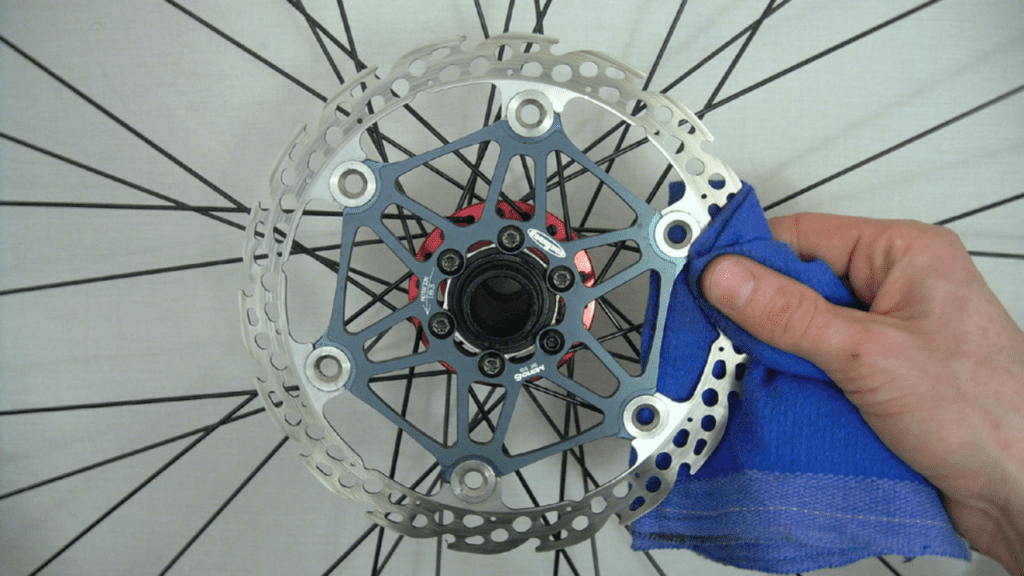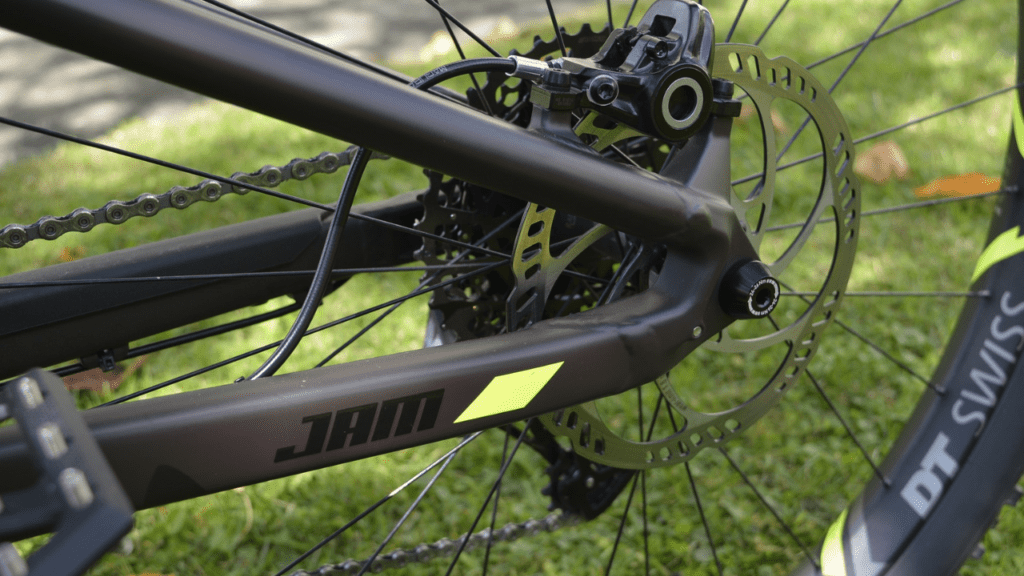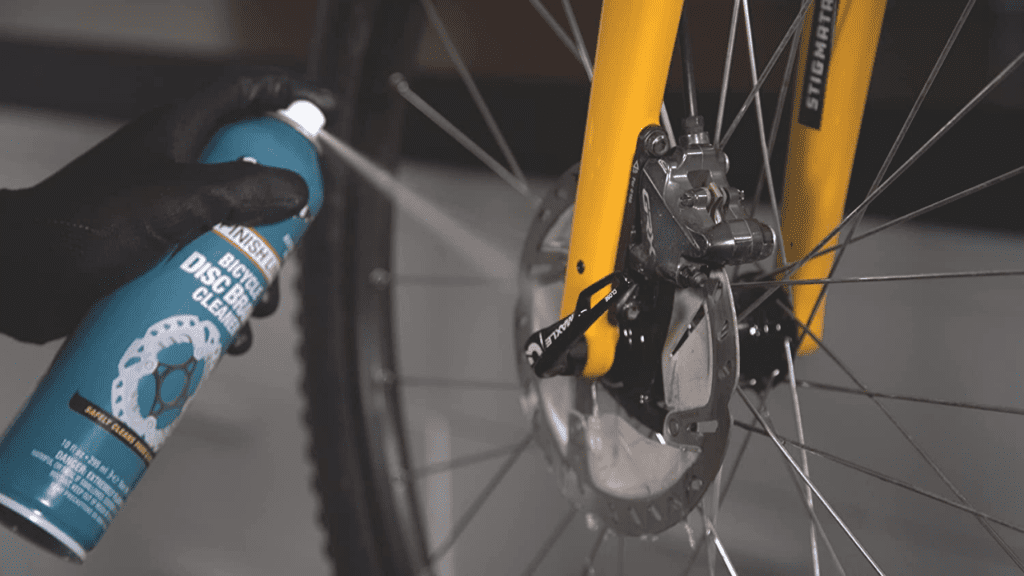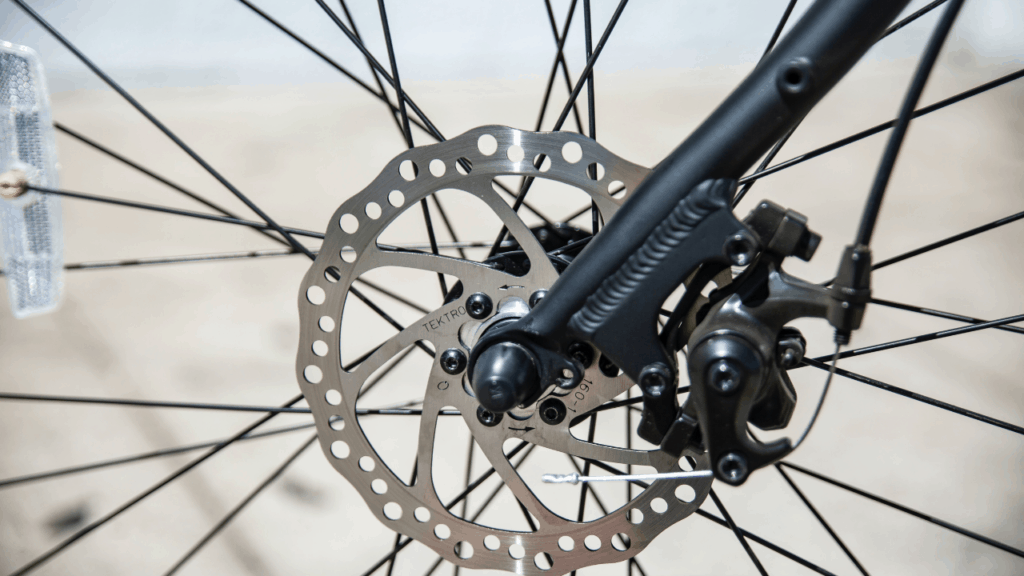How To Clean Disc Brakes on A Mountain Bike
/ Tips / How To Clean Disc Brakes on A Mountain Bike
Want to learn how to clean disc brakes on a mountain bike?
Here you’ll find out what you can use to clean your mountain bike disc brakes, how to detach the disc brakes and their entire cleaning in your garage.
Mountain Bike Disc Brake Cleaning Overview
You can clean your mountain bike disc brakes after removing your wheels, wiping those brakes with brake cleaner and a clean rag. You can also use isopropyl alcohol for this purpose.
Furthermore, for tuning your disc brakes, scuff the clippers and pads using sandpaper, reinstall, and bed them in. But how to determine whether you have disc brakes on your mountain bike or not?

Determining the Types of Brakes, You Have
Primarily, there are four different types of brakes on mountain bikes. These include cantilevers, v-brakes, caliper brakes, and disc brakes.
They all have their positives and negatives. However, disc brakes are most potent on mountain bikes, and hence they are used the most.
Determining whether you have disc brakes on your mountain bikes is straightforward. You can have just a glance at your MTB for this.
Therefore, if your MTB has disc brakes, you will see a small circle right at the center of your tires. These circles are made of metal. Furthermore, a brake caliper will be there when you see the brake pads.
Types of disc brakes
Mountain bikes come with two kinds of disc brakes. One type is mechanical disc brakes. These disc brakes will have a normal lever that is connected to the caliper with a cable.
The second type is hydraulic disc brakes. Their lever is connected with the clipper using a hose that has a hydraulic fluid (incompressible). Hydraulic disc brakes are modern, more powerful, and highly responsive. However, they are way more expensive upfront and to maintain.
Telling the difference whether you have mechanical or hydraulic disc brakes is straightforward. Bikes with mechanical brakes have wire near the brake caliper connected to it. At the same time, bikes with hydraulic brakes will only have a hydraulic tube going into the caliper itself.

How to Remove Mechanical/Hydraulic Disc Brakes?
To begin with, how to clean disc brakes on a mountain bike, first, you need the right tools in your hand to begin the job. You will need:
- Needle nose pliers.
- The correct screwdriver (Torx or hex wrench based on compatibility).
- A flat surface tool for pressing the pistons (in the case of hydraulic disc brakes).
Steps to remove the brakes
Now, let us get to the main part of how to clean disc brakes on a mountain bike. Place your mountain bike on a bike rack or a stand, and remove the wheel. Once you have removed your wheel, remove those brake pads and the disc using one of the methods to remove a particular brake caliper that your MTB comes with.
- If you have a pin-style brake caliper, use your needle nose plier to pull that pin and push the caliper out. Make sure that you don’t lose your pin while you are cleaning.
- With spring-style brake calipers, you can use your pliers to compress those pads and pull the caliper out from the back.
- With magnet-style brake calipers, pull them out from the front using pliers.
- If you have clip-style brake clippers, pull them out with your needle nose pliers with some force, as they are pretty tight.
Once you are done with the brake calipers, you have to remove the disc. For this, you will have to remove all the torque screws that are holding your frame.
How to Clean Disc Brakes on Mountain Bikes at Home
The procedure of how to clean disc brakes on a mountain bike is simple if you have the right tools and materials at hand. You will need,
- Gloves made of latex or nitrile.
- Brake cleaning fluid (Finish Line has a great cleaner).
- Fine sandpaper (wet/dry) over 1000.
- Lint-free cleaning shop towels.
Cleaning the disc brakes
Here are the steps that you need to follow on how to clean disc brakes on a mountain bike.
- You have to begin by wearing your latex or nitrile gloves to prevent any oil transfer on your brakes. Next, place your brake pads and your disc on a bed of lint-free towels.
- Use isopropyl alcohol and spray the pads and the disc generously. Make sure not to go for any regular brake cleaner as it has oils in it at times. We will talk about it in detail in a bit. But, until the brake cleaner completely evaporates, keep wiping any residue.
- Now, use your sandpaper to rough up the surface of your brake pads and the section of your disc that will be in contact with the pads. Moreover, you need to clean them again with that brake cleaner after this.
- It is time to reinstall the brake pads and the disc and remount the wheel to your bike. Again, keep your latex gloves on at this time.

Preparing Your Brake Calipers for Cleaned Brake Pads
● For mechanical disc brake calipers
You will have to turn that caliper adjustment counterclockwise (to the left all the way). As a result, it will release any tension on your cable system.
● For hydraulic disc brake calipers
You must press the pistons back within the caliper body using a flat tool. Make sure never to press the brake lever when your wheel is off. Otherwise, you will have to repeat the process.
You can also check for any leaks in your hydraulic disc brake system right near the caliper. It will help you find the source of any oil substances getting on brake pads or your disc.
If you find any leakages, fix them right away. Otherwise, your braking system will malfunction, and it will become hazardous while riding the bike.
Check to See If Your Brake Pads Need a Replacement
These brake pads work when they create friction as they rub together with the metallic disc to stop your MTB. Over time, these pads deteriorate and start causing squeaks, ultimately losing their functionality altogether.
A brake pad needs to be 1mm in thickness at least. If they are not in this condition, you need to replace them immediately.
Stacking three credit cards (regular size) replicates the thickness of approximately 1mm. But you can use a vernier caliper to measure the correct thickness of your brake pad.
These brake pads don’t come cheap, so it is understandable if you don’t want to replace them unless you need to. But if they do not function properly, then riding becomes dangerous. So, you better not cut corners in this particular area of maintaining your MTB.
Bedding the New Brakes In
New brake pads have a smooth layer that protects the pad before it is installed. But this smooth layer will also make them work ineffectively at first. Therefore, you will have to bed them in to make them fully functional right away.
For this, you will first have to install the new pads. After that, put a few drops of water on your pad. Now, get on your bike and ride it at a moderate speed, ranging between five to eight miles an hour. Now, cycle your brakes on/off while you are still pedaling.
Repeat this entire process about twenty more times and put in a small bit of water each time. As a result, that initial smooth layer will clean away, along with any residue.
What Can I Clean My Bike Disc Brakes With?
The consensus is in favor of using a cleaner that is specifically designed for this purpose. It is critical because it will not leave any residue. Therefore, you can use isopropyl alcohol for this.
However, experts also say that methylated spirits also work similarly. But do not use white spirits, as they will leave an oily film on your disc brakes, leaving them to function improperly.
It is better to go with the brake cleaners specifically designed for bicycles, particularly MTBs. These disc brakes function the best with a consistent surface for braking from the pads to the rotors. Therefore, using isopropyl alcohol is more effective as it removes grime without any residue.
Using water and a mild soap is also effective for cleaning disc brakes. It prevents any contamination on your rotor and brake pads.
Can you use a Bike Cleaner on Disc Brakes?
You don’t need to go for bike cleaners or other sprays to clean your disc brakes. Furthermore, do not use any compressed sprays as they can cause a top seal.
Spraying any lubricant right at the end of your lever will contaminate the seals. As a result, your level will feel sluggish. Therefore, you need to stick to isopropyl alcohol or soap and water.
With that being said, there are some brake cleaners to clean your disc brakes. For example, the Brake Juice cleaner is specifically designed for bicycles and is low in toxicity.
Such cleaners can prolong the life of your brake pads as they don’t cause any deterioration. Moreover, look for cleaners that do not corrode or rust the calipers on any other metal parts.

Can I Spray Brake Cleaner on Brake Pads?
As mentioned above, it is better to refrain from brake cleaners on your mountain bike disc braking system. They can not only reduce the functionality of your braking system but can also create residue.
Some of them are toxic enough to cause deterioration of your brake pads. Therefore, make sure to only go for brake cleaners that are bike-specific. But we strongly recommend methylated spirits or isopropyl alcohol.
Can I Clean Mountain Bike Brake Pads?
If your brake pads have become contaminated with oil or something, you can go for different remedies. For example, some people recommend putting them in your oven.
You can also use a blow torch to burn those contaminants off. However, bike experts say that this shouldn’t be done, and the only way for you is to replace your brake pads.
But if you don’t want to spend on new pads, you can rub your pads with sandpaper. But remember to put them back on the same side as they might be worn out at an angle.
Conclusion
How to clean disc brakes on a mountain bike is a pretty straightforward DIY project. But, of course, that is if you already have some DIY experience under your belt. But you don’t have to go through much for this endeavor.
Make sure you have the correct tools at hand. Furthermore, don’t go for just any brake cleaner as the bike experts do not recommend them. Instead, a simple solution of soap and water or isopropyl alcohol is a top recommendation by most.
Related Articles
What Does Travel Mean On A Mountain Bike?
Oli L • March 22, 2022
When you start mountain biking you will hear the term "travel" quite a bit. But what the heck is travel and what does it have to do with mountain biking? "Hey, dude, how much travel do you have on your front fork". This is something you will hear often and it's referring to how much suspension you have on your bike. Travel on a mountain bike is the distance you...
What Is A Mountain Bike Dropout?
Oli L • March 1, 2022
The Mountain bike dropout is not a topic of most conversations when it comes to mountain biking. These components are located on the fork-end and features a section in the frame or the fork, where the wheel can quickly be loosened and removed in the need of a wheel change. In more technical terms, it refers to a slot located in the rear axle of the mountain bike, that allows...
How to Manual on a Mountain Bike
Oli L • November 9, 2021
When you're cruising on a mountain bike or pacing through a trail, you face different problems. One such problem is the obstacles that you face while conquering trails. To overcome these obstacles, there's a popular skill that is known as a manual. With a manual, you can pass over these obstacles in style and comfort. And like every skill, this mountain biking skill requires practice. Because without practice, even if...
Hydraulic Disc Brakes Vs. Mechanical Disc Brakes
Oli L • September 9, 2021
One of the most common topics in the biking world is "hydraulic disc brakes vs. mechanical disc brakes." And so it should be because most of the bikes either come with hydraulic disc brakes or mechanical ones. Hydraulic disc brakes are the dominant of the two. These brakes are complex but reliable. However, mechanical brakes are under-performing but straightforward than their counterparts. So, which one will be better for your...
How To Measure the Wheel Size of a Bike?
Oli L • September 3, 2021
So, are you looking to purchase a replacement or a spare tire for your mountain bike? But you don't know how to measure the wheel size of a bike? In this guide, we will list some details associated with how to measure the wheel size of a bike. And the best part is that you can use these techniques to measure the wheel size of any bike. Wheel size measurement...
Latest Articles
Popular Articles
Product Of The Week
Monday 16th June
